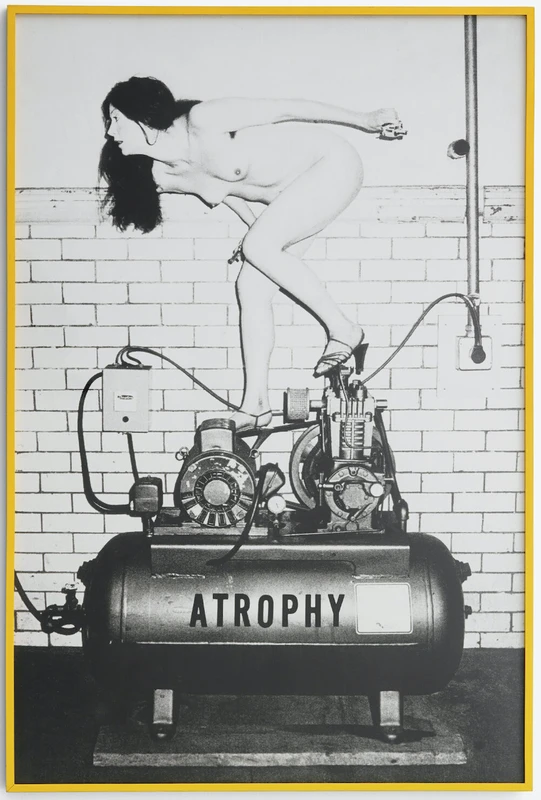Linder | Hannah Wilke
2 Feb-11 Mar 2023
PV 1 Feb 2023, 6-8pm


Alison Jacques presents a two-person exhibition pairing, for the first time, internationally renowned artists, Linder (b.1954, Liverpool, UK) with Hannah Wilke (b.1940, New York; d.1993, Houston, US).
The exhibition runs concurrent to Linder’s solo exhibition ‘A Dream Between Sleeping and Waking’ ongoing at Charleston, UK (until 12 March 2023), and follows ‘Hannah Wilke: Art for Life’s Sake’, Wilke’s major survey at the Pulitzer Arts Foundation, St. Louis, Missouri, US (2021–22).
Both artists are recognised as pioneers, provocateurs and radical feminists with work spanning photography, performance, photomontage, and in Wilke’s case, sculpture and drawing. Raising shared questions in their individual practices around gender, the portrayal of women’s sexuality against domesticity, and the commodification of the body, both Linder and Wilke openly criticise the conventional female roles and representation specific to each of their generations.
For Linder, this exhibition focuses on photomontages from 2007 to the present, in which she explores the possibilities for subverting the deeply encoded narratives sold through pornographic magazines of the 1970s 80s. Through a lens of humour and the surreal, Linder juxtaposes images of furniture, domestic appliances, shells, cakes, flowers and in particular, the rose, mimicking the absurdity of gendered consumerism. ‘I like to see how far I can ramp up desire within one image until it becomes grotesquely comic...’
For Wilke some of the works here focus on her subversion of consumer fantasies developed through the commercial advertising of the time. Wilke employed her naked body, often in provocative poses, so she could become, ‘...representative of every woman.’ In her S.O.S. Starification Object Series (1974–82), Wilke affixes chewed gum to her body, folded into vulva-like forms, bridging an overarching desire to create ‘a formal imagery that is specifically female,’ and that sought to reclaim what had for centuries been declared taboo. Wilke chose chewing gum to do this ‘because it’s the perfect metaphor for the American woman—chew her up, get what you want out of her, throw her out and pop in a new piece.’
For Linder, the rose is a signature weapon as is the vaginal fold for Wilke, who repeatedly returned to this sculptural form, experimenting with it through such radical materials as latex, erasers, gum, and, originally, terracotta, clay, and, later, porcelain. While the historic interpretation of Linder’s iconography is associated as a proxy ‘for romantic sentiment, incarnating love and fidelity’; Wilke often referred to Venus, commonly associated with our libidinal drive for sexual pleasure. Wilke’s sentiment ‘...the most viable experience we have is making love,’ takes on renewed gravitas in two flower watercolours from 1990, given her death soon after aged 52.
Central to the practices of both artists is language, particularly the malleability of words. For Linder, this development is mapped through an early large-scale photographic installation SheShe (1981), photographed by Birrer, which pairs her own composed lyrics with a series of portraits as she performs for us, as the voyeur on the other side of the camera. In her Escort series, Linder leaves the accompanying magazine captions visible, presenting them at once as both laughable and ironic. Similarly, Wilke employed word play in the titling of her works, as in the filmed performance and the photographic series including text So Help Me Hannah, and as her artistic trajectory evolved so did her use of language. While humour remained a cornerstone, Wilke utilised confrontational statements in a similar fashion to advertising slogans. In doing so, Wilke’s desire to be seen as representative of every woman, takes on new fervour when presented in tandem with the women that populate Linder’s works.
Linder’s recent solo exhibitions include: ‘A Dream Between Sleeping and Waking’, Charleston, Firle (2022–23); Kettle’s Yard, Cambridge (2020); Nottingham Contemporary (2018); Hepworth Wakefield (2013) and Tate St. Ives (2013). Museum collections include Tate, London; MOMA, New York and The Deste Foundation, Athens.
Hannah Wilke’s work has been included in major museum exhibitions: ‘She-Bam Pow POP Wizz! The Amazons of Pop’, MAMAC, Nice (2020–22); ‘Performing for the Camera’, Tate Modern, London (2016); ‘Elles: Women Artists from the Centre Pompidou’, Paris (2012–13) and ‘WACK! Art and the Feminist Revolution’, Museum of Contemporary Art, Los Angeles (2007–08). Accompanying Hannah Wilke’s recent survey at The Pulitzer Arts Foundation, St. Louis, Missouri (2021–22) is the book ‘Hannah Wilke, Art for Life’s Sake’ Princeton University Press. This follows catalogues accompanying the exhibitions: ‘Eva Hesse/Hannah Wilke: Erotic Abstraction’, Acquavella, New York (2021), ‘Hannah Wilke: Sculpture in the Landscape,’ The Tyler School of Art and Architecture, Temple University, Philadelphia (2019) Wilke’s alma mater. In 2010 Prestel published the monograph ‘Hannah Wilke’ written by Nancy Princenthal. Wilke’s work has been acquired by major museums including MOMA, New York; LACMA, Los Angeles; Guggenheim, New York; Whitney Museum of American Art, New York; The Carnegie Museum of Art, Pittsburgh; Centre Pompidou, Paris, Reina Sofía, Madrid and Tate, London.